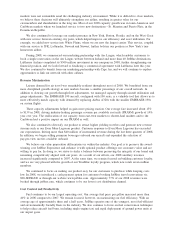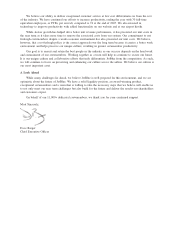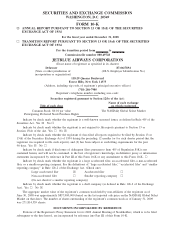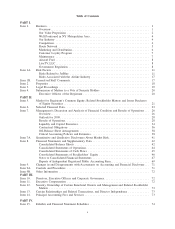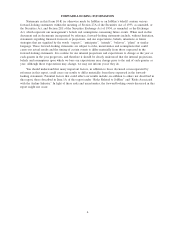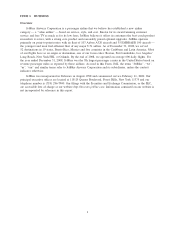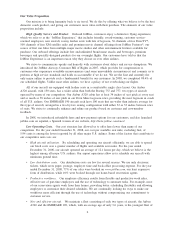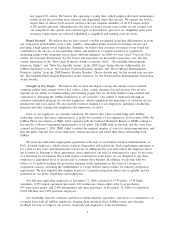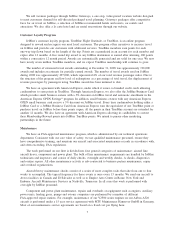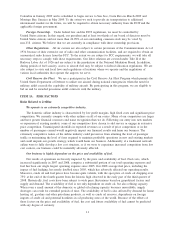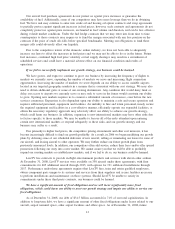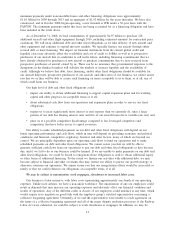JetBlue Airlines 2008 Annual Report Download - page 13
Download and view the complete annual report
Please find page 13 of the 2008 JetBlue Airlines annual report below. You can navigate through the pages in the report by either clicking on the pages listed below, or by using the keyword search tool below to find specific information within the annual report.Well-Positioned in New York Metropolitan Area, the Nation’s Largest Travel Market.
Since 2000, the majority of our operations have originated in New York City, the nation’s largest travel
market. We are the largest airline at New York’s John F. Kennedy International Airport, or JFK, as measured
by passengers and, by the end of 2008, our domestic operations at JFK were almost equal to those of all other
airlines combined. In addition to JFK, we serve Newark’s Liberty International Airport, New York’s
LaGuardia Airport, Newburgh, New York’s Stewart International Airport and White Plains, New York’s
Westchester County Airport. JFK is New York’s largest airport, with an infrastructure that includes four
runways, large facilities and a convenient direct light-rail connection to the New York City subway system and
the Long Island Rail Road. In October 2008, after three years of construction, we commenced operations at
our new 26-gate terminal at JFK’s Terminal 5. Terminal 5 has an optimal location with convenient access to
active runways, which we believe will increase the efficiency of our operations. We believe that this new
terminal with its modern amenities, concession offerings and passenger convenience will become as integral to
the JetBlue Experience as our in-flight entertainment systems. Operating out of the nation’s largest travel
market does make us susceptible to certain operational constraints.
Our Industry
The passenger airline industry in the United States has traditionally been dominated by the major
U.S. airlines, the largest of which are American Airlines, Continental Airlines, Delta Air Lines, Northwest
Airlines, Southwest Airlines, United Air Lines and US Airways. The U.S. Department of Transportation, or
DOT, defines the major U.S. airlines as those airlines with annual revenues greater than $1 billion. There are
currently 18 passenger airlines meeting that standard. These airlines offer scheduled flights to most large cities
within the United States and abroad and also serve numerous smaller cities. The six largest major
U.S. airlines, other than Southwest, have adopted the traditional “hub and spoke” network route system, or
traditional network. This type of system concentrates most of an airline’s operations at a limited number of
hub cities, serving the majority of other destinations in the system by providing one-stop or connecting service
through the hub.
Regional airlines, such as SkyWest Airlines and Mesa Airlines, typically operate smaller aircraft on lower
volume routes than do traditional network airlines. Regional airlines typically enter into relationships with one
or more traditional network airlines under which the regional airline agrees to use its smaller aircraft to carry
passengers booked and ticketed by the traditional network airline between their hubs and a smaller outlying
city. There are currently six regional U.S. airlines within the “major” designation.
Low-cost airlines largely developed in the wake of deregulation of the U.S. airline industry in 1978,
which permitted competition on many routes for the first time. Southwest Airlines pioneered the low-cost
model, which enabled it to offer fares that were significantly lower than those charged by traditional network
airlines. Excluding JetBlue, there are currently three low-cost major U.S. airlines.
Following the September 11, 2001 terrorist attacks, low-cost airlines were able to fill a significant
capacity void left by traditional network airline flight reductions. Lower fares and increased low-cost airline
capacity created an unprofitable operating environment for the traditional network airlines. Since 2001, the
majority of traditional network airlines have undergone significant financial restructuring, including
bankruptcies, mergers and consolidations. These restructurings have allowed them to reduce labor costs,
restructure debt, terminate pension plans and generally reduce their cost structure, increase workforce
flexibility and provide innovative offerings similar to those of the low-cost airlines, while still maintaining
their expansive route networks, alliances and frequent flier programs. Although our costs remain lower than
those of our largest competitors, the difference in the cost structures, and the competitive advantage previously
enjoyed by low-cost airlines, has diminished.
Competition
The airline industry is highly competitive. Airline profits are sensitive to even slight changes in fuel costs,
average fare levels and passenger demand. Passenger demand and fare levels historically have been influenced
by, among other things, the general state of the economy, international events, industry capacity and pricing
actions taken by other airlines. The principal competitive factors in the airline industry are fares, customer
4


